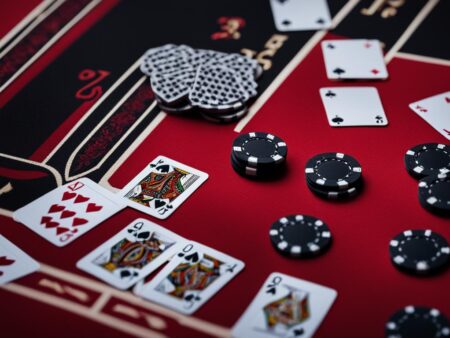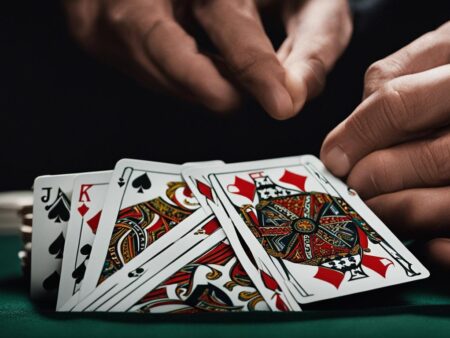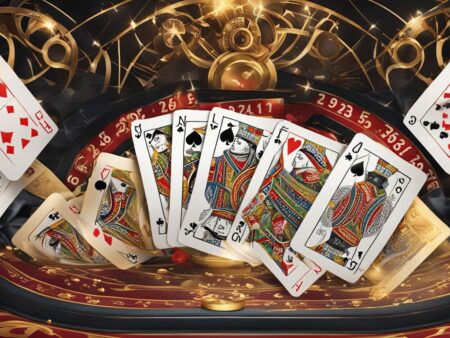Welcome to our comprehensive guide on how to master the game of 13 vs 3 blackjack. In this article, we will delve into the rules, strategies, and tips that will help you improve your gameplay and increase your chances of winning. Whether you’re a seasoned player or a beginner, understanding the nuances of 13 vs 3 blackjack is essential for success at the tables.
Knowing the best strategies and rules for playing 13 vs 3 blackjack is essential for mastering the game. By understanding the different hand combinations and the dealer’s upcard, players can make informed decisions and improve their chances of winning. In this article, we will explore the importance of knowing your hand 12, strategies for hand 12, and the science behind blackjack. We will also delve into card counting, the impact of table rules on odds, and provide beginner blackjack tips to help you get started on your winning journey.
Key Takeaways:
- Understanding the rules and strategies of 13 vs 3 blackjack is crucial for success.
- Knowing the optimal strategies for hand 12 and hand 13 can greatly improve your odds.
- Learning perfect basic strategy and implementing it can reduce the house edge.
- Choosing the right blackjack game with favorable rules can increase your chances of winning.
- Beginner blackjack tips such as playing games with higher payouts and avoiding risky betting systems can improve your gameplay.
The Importance of Knowing Your Hand 12
In the game of 13 vs 3 blackjack, understanding the optimal strategies for each hand is crucial for success. One hand that often presents a challenge for players is hand 12. To make informed decisions, players must consider their hand value and the dealer’s upcard.
Hand 12 is a delicate situation because the player risks busting if they hit. However, standing may also result in a weak hand that is prone to being beaten by the dealer. To navigate this situation effectively, it is essential to analyze the dealer’s upcard.
If the dealer’s upcard is a 4, 5, or 6, the probability of the dealer busting is higher. In this case, it is generally recommended to stand on hand 12. However, if the dealer’s upcard is anything other than a 4, 5, or 6, it is advisable to hit. This strategy ensures that players maximize their chances of improving their hand without risking busting.
| Dealer’s Upcard | Player’s Hand 12 | Recommended Action |
|---|---|---|
| 4, 5, or 6 | 12 | Stand |
| Any other card | 12 | Hit |
By following these guidelines and understanding the specific strategies for hand 12, players can make more informed decisions and improve their overall gameplay. Remember, blackjack is a game of probabilities, and every decision counts.
Strategies for Hand 12
When playing 13 vs 3 blackjack, knowing the right strategies is crucial to maximize your chances of winning. One of the most challenging situations players often encounter is when they have a hand 12. In this scenario, it’s essential to consider the dealer’s upcard to make the best move.
Against a dealer’s upcard of 4, 5, or 6, it is generally recommended to stand. This is because these upcards result in high bust rates for the dealer. By standing, you allow the dealer to potentially go over 21, increasing your chances of winning the hand. However, against any other upcard, it is advisable to hit. The probability of the dealer busting is higher with small cards (4-6) and lower with higher-value cards (7-A).
By following these strategies for hand 12, you can make more informed decisions and improve your odds of winning in 13 vs 3 blackjack. Keep in mind that these strategies may vary depending on the specific rules of the game and the number of decks in play. It’s always recommended to familiarize yourself with the rules and adjust your strategy accordingly.
Strategies for Hand 12
| Dealer’s Upcard | Player’s Action |
|---|---|
| 4, 5, 6 | Stand |
| 2, 3, 7, 8, 9, 10, A | Hit |
As shown in the table above, when facing a dealer’s upcard of 4, 5, or 6, standing is the optimal move. However, against any other upcard, hitting is the recommended action. These strategies are based on statistical analysis and aim to maximize your chances of winning the hand. Remember, blackjack is a game of probabilities, and making the right decisions can significantly improve your outcomes.
Play with Confidence
When playing 13 vs 3 blackjack, understanding the strategies for hand 12 is just one piece of the puzzle. It’s crucial to have a solid grasp of the game’s rules, know when to hit, stand, double down, or split, and manage your bankroll effectively. By combining strategy with sound decision-making, you can approach each hand with confidence and increase your overall success in the game.
Hand 12 Against 2 or 3 as the Dealer’s Up Card
When playing 13 vs 3 blackjack, one situation that often causes confusion is when the dealer’s upcard is a 2 or 3 and the player has a hand totaling 12. Many players instinctively stand in this situation, thinking it is the safest move. However, hitting is actually the more advantageous strategy.
By hitting with a hand 12 against a dealer’s upcard of 2 or 3, players increase their chances of improving their total without risking an immediate bust. There are more card denominations (5-9) that can improve the player’s hand than those that would cause them to bust. In fact, hitting in this scenario can lead to a higher probability of winning in the long run.
It is important to understand that 13 vs 3 blackjack strategy is not solely based on the player’s hand, but also takes into consideration the dealer’s upcard. By making the optimal decision in this specific scenario, players can further enhance their chances of success at the blackjack table.
Understanding Hand 13
Hand 13 is one of the key hands in 13 vs 3 blackjack strategy. It is essential to approach this hand with the right tactics to maximize your chances of winning. When you have a hand 13 and the dealer’s upcard is 2-6, it is best to stand. This is because the dealer has a higher probability of busting when their upcard is low. On the other hand, if the dealer’s upcard is 7 to Ace, it is advisable to hit. With stronger cards, the dealer’s chances of busting decrease, so it is better to try and improve your hand.
Regardless of the number of decks or whether the dealer must hit or stand on soft 17, the strategy for hand 13 remains consistent. Standing against a dealer’s upcard of 2-6 and hitting against 7-A ensures that you make the most optimal decisions based on the probabilities of busting. This strategy may seem counterintuitive to new players, but it has been proven to be statistically advantageous in the long run.
To better understand the strategy for hand 13, let’s take a look at the following table:
| Dealer’s Upcard | Player’s Hand 13 | Optimal Move |
|---|---|---|
| 2-6 | 13 | Stand |
| 7-A | 13 | Hit |
By following this strategy consistently, you can improve your overall performance in 13 vs 3 blackjack. Remember, blackjack is a game of math and probabilities, so it is crucial to make decisions based on data and statistical analysis rather than intuition or gut feelings.
“When you have a hand 13 and the dealer’s upcard is 2-6, it is best to stand.”
The Science Behind Blackjack
When it comes to playing blackjack, there’s more to it than just luck. The game is based on math and statistics, and understanding the rules and strategies can greatly improve your chances of winning. By making informed decisions based on probabilities, you can maximize your winning potential and outsmart the dealer.
The rules of blackjack dictate the actions you can take based on your hand and the dealer’s upcard. Knowing when to hit, stand, double down, or split can make a significant difference in your overall gameplay. It’s important to study and practice basic blackjack strategy to ensure you’re making the best move in each situation.
One of the key aspects of blackjack is understanding the odds. The probabilities of certain card combinations and the likelihood of the dealer busting can help you determine your next move. By keeping track of the cards that have already been played and using card counting techniques, some players aim to gain an advantage over the house. However, it’s important to note that card counting may not be welcomed by all casinos.
| Blackjack Strategies | Description |
|---|---|
| Perfect Basic Strategy | A mathematically correct strategy for every possible hand combination, reducing the house edge and increasing player’s odds of winning. |
| Card Counting | A strategy that involves keeping track of the cards played to predict future outcomes and gain an advantage over the house. |
| Understanding Odds | Being aware of the probabilities of different card combinations and the likelihood of dealer busting. |
Ultimately, mastering blackjack requires a combination of knowledge, strategy, and skill. By understanding the science behind the game and implementing effective strategies, you can improve your odds and increase your chances of success at the blackjack table.
The Importance of Learning Perfect Basic Strategy
When it comes to playing blackjack, it is essential to learn and master the Perfect Basic Strategy. This strategy is the mathematically correct action for each combination of cards dealt in the game. By following this strategy, players can significantly reduce the house edge and greatly improve their odds of winning.
Perfect Basic Strategy is based on probability and statistics, taking into account the player’s hand and the dealer’s upcard. It helps players make the best decisions in every situation, maximizing their chances of success. By using Perfect Basic Strategy, players can avoid common mistakes and minimize their losses.
Charts are available that outline the optimal action for each hand combination. These charts provide a clear and easy-to-follow guide for players. By referring to these charts during gameplay, players can confidently make the correct decision and increase their chances of winning.
Table: Perfect Basic Strategy
| Player Hand | Dealer’s Upcard | Optimal Action |
|---|---|---|
| Hard 5-8 | Any | Hit |
| Hard 9 | 2-6 | Double Down |
| Hard 9 | 7-Ace | Hit |
| Hard 10 | Any | Double Down |
| Hard 11 | 2-Ace | Double Down |
| Hard 12 | 4-6 | Stand |
| Hard 12 | Any | Hit |
| Hard 13-16 | 2-6 | Stand |
| Hard 13-16 | 7-Ace | Hit |
| Hard 17-21 | Any | Stand |
| Soft 13-15 | Any | Hit |
| Soft 16-18 | 2-6 | Double Down |
| Soft 16-18 | 7-Ace | Hit |
| Soft 19-21 | Any | Stand |
| Pairs | Any | Split |
Tips for Improving Your Odds
In addition to learning Perfect Basic Strategy, there are other methods that players can implement to further improve their odds in blackjack. By following these tips, you can increase your chances of winning and maximize your enjoyment of the game.
Choose Games with Favorable Rules
When selecting a blackjack game to play, it is important to consider the specific rules of the table. Different variations of blackjack may have different rules regarding doubling down, splitting pairs, and surrendering. By choosing games with favorable rules, such as those that pay out 3:2 or more for a natural blackjack, you can increase your potential payouts and reduce the house edge.
Play Games with Fewer Decks
Another tip for improving your odds in blackjack is to play games with fewer decks. In general, the fewer decks used in the game, the lower the house edge. This is because with fewer decks, it becomes easier to keep track of the cards that have been played, giving you a better idea of what cards are remaining in the shoe and allowing you to make more informed decisions.
Avoid Risky Betting Systems
While there are many betting systems that claim to guarantee success in blackjack, it is important to approach them with caution. One popular but risky betting system is the Martingale system, where players double their bet size after each loss. While this strategy may seem tempting, it can quickly lead to significant losses if a losing streak occurs. Instead, focus on using sound strategies based on the math and probabilities of the game.
By implementing these tips and strategies, you can improve your odds in blackjack and increase your chances of walking away a winner. Remember to always play responsibly and within your limits. Good luck at the tables!
Introduction to Card Counting
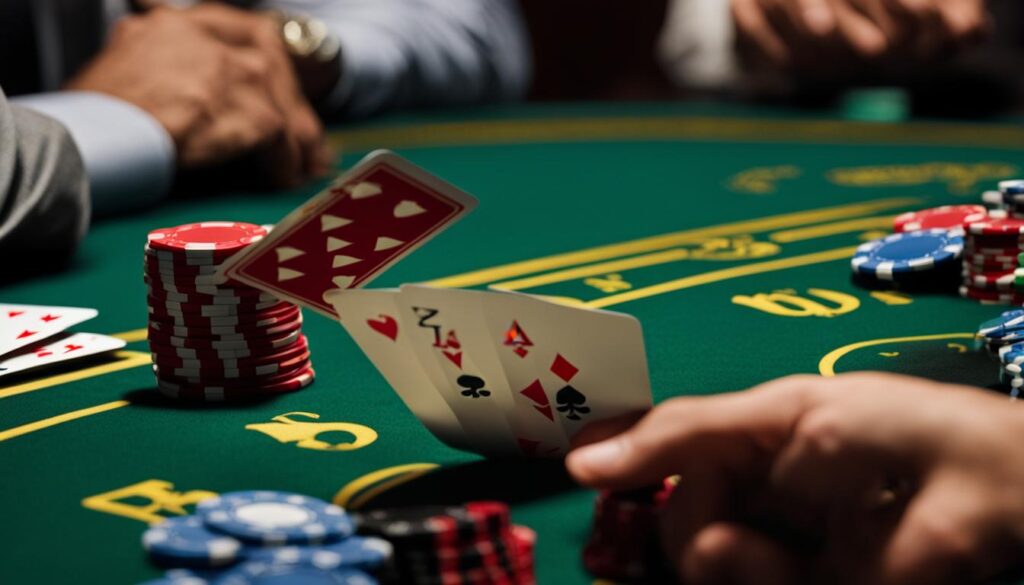
Card counting is a powerful strategy that can give players an advantage in blackjack by keeping track of the cards that have been dealt. Although not illegal, casinos may frown upon card counting and may ask players to leave if they are caught using this technique. However, when employed correctly, card counting can significantly increase a player’s chances of winning and can be a valuable tool in their blackjack strategy.
One of the most effective card counting strategies is the High/Low system. This method assigns a value of -1 to high cards (10, J, Q, K, A) and a value of +1 to low cards (2, 3, 4, 5, 6). As the cards are dealt, players keep a running count in their head, adding the positive values for low cards and subtracting the negative values for high cards. The running count is then used to determine the true count by dividing it by the number of decks that are still in play. The true count is a more accurate representation of the remaining favorable cards and allows players to adjust their betting and playing decisions accordingly.
Implementing card counting requires practice and concentration. Players must be able to keep a running count while also making decisions based on their hand and the dealer’s upcard. It is important to note that card counting is not a guaranteed way to win, as it only provides players with an edge over the long term. Additionally, it is essential to avoid being detected by casino surveillance, as being labeled as a card counter can result in being banned from the casino.
While card counting can be a valuable addition to a player’s blackjack strategy, it is not suitable for everyone. It requires a significant investment of time and effort to become proficient, and it may not be practical for casual players or those without the necessary bankroll. However, for dedicated players who are willing to put in the work, card counting can be a powerful tool to gain an advantage at the blackjack table.
Table: Comparison of Card Counting Systems
| Card Counting System | Level of Difficulty | Effectiveness | Recommended for |
|---|---|---|---|
| High/Low | Medium | High | Intermediate players |
| Hi-Opt I | Medium | High | Intermediate players |
| Hi-Opt II | Advanced | High | Experienced players |
| Omega II | Advanced | High | Experienced players |
The Impact of Table Rules on Odds
In the game of blackjack, the specific rules of the table can have a significant impact on a player’s chances of winning. Different variations of blackjack may have different rules regarding doubling down, splitting pairs, surrendering, and other options. It is essential for players to understand and consider these rules when making decisions during gameplay. Let’s explore how these table rules can affect the odds and influence the outcome of a blackjack hand.
Doubling Down
Doubling down is a popular blackjack strategy that allows players to double their initial bet in exchange for receiving only one additional card. However, the rules for doubling down can vary between different blackjack games. Some tables may allow players to double down on any two cards, while others may restrict doubling down to certain hand totals, such as 9, 10, or 11. Understanding the doubling down rules of a specific blackjack game is crucial as it can impact the overall odds of winning.
Splitting Pairs
Splitting pairs is another strategy commonly used in blackjack, especially when dealt with a pair of the same rank (e.g., two 8s). When players split pairs, they separate the original hand into two separate hands and place an additional bet equal to their initial wager. The rules for splitting pairs can vary as well. Some tables may allow players to split pairs multiple times, while others may limit the number of splits or restrict certain pairs from being split. Understanding the splitting rules of a blackjack game is important as it can affect the player’s ability to optimize their hand and improve their odds.
Surrendering
Surrendering is an option that allows players to forfeit their hand and recover half of their initial bet. This option can be advantageous when facing a challenging hand, such as a hard 15 against a dealer’s 10. However, not all blackjack games offer the surrender option, and the rules for surrendering can vary between tables. Some games may provide an early surrender option, allowing players to surrender before the dealer checks for blackjack, while others may only allow a late surrender after the dealer checks for blackjack. Understanding the surrender rules of a particular blackjack game can impact a player’s ability to minimize losses and improve their overall odds.
Knowing the specific table rules of a blackjack game is crucial for making informed decisions and improving the odds of winning. By understanding the impact of different rules on doubling down, splitting pairs, and surrendering, players can adapt their strategy and maximize their chances of success. Remember, the key to mastering blackjack lies in understanding the rules and implementing optimal strategies.
Basic Blackjack Instructions
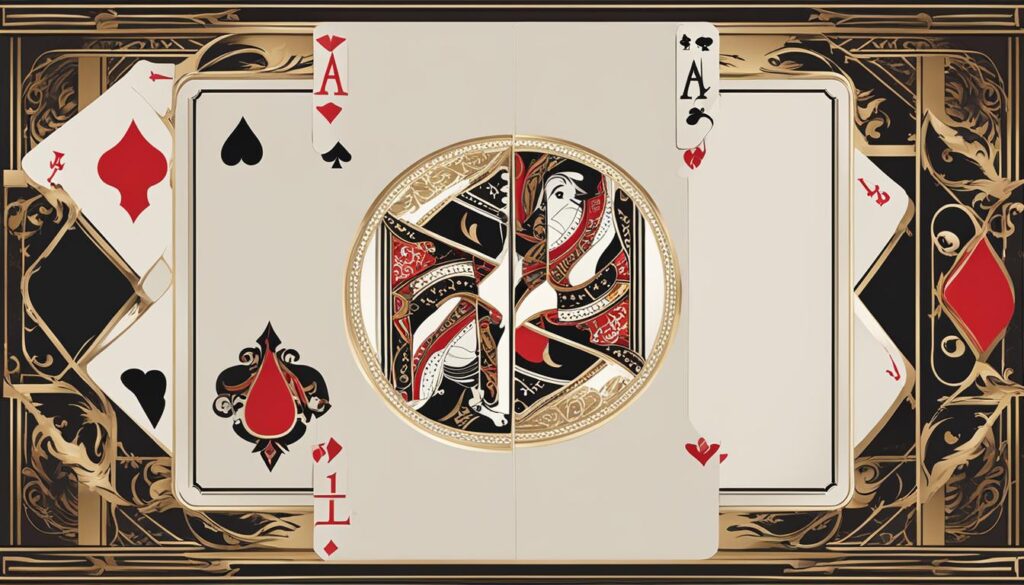
Before diving into the world of blackjack, it is crucial to understand the basic instructions of the game. Knowing the rules and gameplay will not only enhance your understanding but also improve your chances of winning. Let’s explore the fundamental aspects of playing blackjack:
- Rules: Blackjack is a card game where the objective is to have a hand total higher than the dealer’s without exceeding 21. The game starts with each player receiving two cards and the dealer also receiving two cards, one face-up and one face-down.
- Hand Values: Each card in blackjack holds a specific value. Number cards from 2 to 10 are worth their face value, face cards (Jack, Queen, King) are worth 10, and Aces can be worth either 1 or 11, depending on the situation.
- Player Decisions: After receiving your initial two cards, you have several choices to make:
- Hit: If you want another card to improve your hand, you can choose to hit. Be careful not to exceed 21, as this results in an automatic loss.
- Stand: If you are satisfied with your hand, you can choose to stand and let the dealer play their hand.
- Double Down: In some situations, you may have the option to double down, which means doubling your initial bet and receiving one additional card.
- Split: If your initial two cards are of the same value, you can choose to split them into two separate hands, each with its own bet.
- Surrender: In some blackjack variations, you may have the option to surrender, which means forfeiting half of your bet and exiting the hand.
- Dealer’s Turn: Once all players have made their decisions, the dealer will reveal their face-down card and play their hand according to predetermined rules. The dealer must hit on a hand total of 16 or less and stand on a hand total of 17 or more.
- Winning: In blackjack, you win if your hand total is closer to 21 than the dealer’s without exceeding 21. A winning hand pays out 1:1, while a blackjack (an Ace and a 10-value card) pays out 3:2.
Understanding these basic instructions will set you on the right path to becoming a successful blackjack player. Remember to play responsibly, manage your funds effectively, and know when to call it a day. Good luck at the tables!
Tips for Success:
1. Familiarize yourself with the specific rules of the blackjack variation you are playing as they may differ slightly.
2. Start with small bets and gradually increase them as you become more comfortable with the game.
“The casino industry is built on a simple principle: it is far more comfortable for the house to take your money in exchange for chips that barely represent a fraction of the value you have put on them.”
3. Practice makes perfect. Utilize online blackjack simulators or play with friends to hone your skills before playing in a casino.
4. Don’t chase losses. Set a budget and stick to it. Blackjack is a game of strategy, not desperation.
| Hand | Dealer’s Upcard | Player Action |
|---|---|---|
| 12 | 4, 5, 6 | Stand |
| 12 | 2, 3 | Hit |
| 13 | 2-6 | Stand |
| 13 | 7-A | Hit |
Table: Recommended player actions for hand 12 and hand 13 based on the dealer’s upcard. These strategies optimize your odds of winning.
Beginner Blackjack Tips
As beginners, it’s important to start your blackjack journey with the right tips and strategies to improve your gameplay and increase your chances of winning. By following these guidelines, you can enhance your understanding of proper basic strategy, optimize your odds, and minimize risks.
1. Understand Proper Basic Strategy
Learning and implementing proper basic strategy is essential for maximizing your chances of winning in blackjack. This strategy is based on mathematical calculations and guides players on the best actions to take based on their hand and the dealer’s upcard. By familiarizing yourself with basic strategy charts, you can make informed decisions that reduce the house edge and increase your odds of success.
2. Play Games That Pay 3:2 or More
When choosing a blackjack game, opt for those that offer payouts of 3:2 or more for a blackjack hand. This payout ratio ensures that you receive a fair return for your winning hand and helps offset the house edge. Avoid games with lower payout ratios, such as 6:5, as they significantly reduce your potential winnings.
3. Choose Games with Fewer Decks
The number of decks used in a blackjack game can impact your odds of winning. In general, games with fewer decks favor the player, as they reduce the house edge. Look for games with fewer decks, such as single-deck or double-deck blackjack, to increase your chances of beating the dealer.
4. Avoid Risky Betting Systems
While it may be tempting to try betting systems like the Martingale system, they can be risky and often result in significant losses. Betting systems that rely on increasing your wager after losses can quickly deplete your bankroll and lead to frustration. Instead, focus on implementing proper basic strategy and making sound, informed decisions based on the specific hand and dealer’s upcard.
By following these beginner blackjack tips, you can improve your gameplay, increase your odds of winning, and enjoy a more successful blackjack experience. Remember to practice responsible gambling and set limits for yourself to ensure a positive and enjoyable gaming session.
The Importance of Choosing the Right Blackjack Game
When it comes to playing blackjack, choosing the right game can have a significant impact on your odds of winning. Different variations of the game may have different rules and payouts, so it’s crucial to understand your options and make an informed decision. By selecting games that offer the best odds and favorable rules, you can maximize your chances of success at the blackjack table.
One important factor to consider when choosing a blackjack game is the variation itself. There are numerous variations of blackjack available, each with its unique set of rules. Some popular variations include Classic Blackjack, European Blackjack, and Spanish 21. It’s essential to familiarize yourself with the specific rules of each variation to determine which one aligns with your playing style and offers the best odds.
Another aspect to consider is the payout structure. Different blackjack games may have varying payout ratios for blackjack hands. It’s advisable to look for games that pay out 3:2 or more, as these tend to have a lower house edge, giving you a better chance of winning. Additionally, pay attention to any additional rules or side bets that may be offered in the game, as these can affect your overall odds.
Table: Comparison of Blackjack Game Variations
| Blackjack Variation | Rules | Payout Ratio |
|---|---|---|
| Classic Blackjack | Dealer stands on all 17s Double down on any two cards Split up to three times |
3:2 |
| European Blackjack | Dealer stands on all 17s No doubling down after splits No surrender option |
3:2 |
| Spanish 21 | No 10s in the deck Player 21 always wins Double down on any number of cards |
Varies |
In addition to variation and payout ratio, it’s essential to consider other table rules that can impact your odds. Look for games with fewer decks, as this reduces the house edge. Also, pay attention to options such as doubling down and splitting, as favorable rules in these areas can further improve your chances of winning. Avoid tables with unfavorable rules, such as restrictions on doubling down or late surrender.
By carefully selecting the right blackjack game, you can significantly improve your odds of winning. Remember to consider the variation, payout ratio, and table rules when making your choice. With a strategic approach and knowledge of the game, you’ll be well on your way to mastering blackjack and increasing your chances of success at the tables.
Conclusion
In conclusion, mastering the game of blackjack requires a deep understanding of the rules and implementing optimal strategies. By considering the different hand combinations and the dealer’s upcard, players can make informed decisions and increase their chances of winning.
When facing a hand 12, players should be aware that it is more beneficial to hit when the dealer’s upcard is 2 or 3, contrary to popular belief. Additionally, hand 13 should be approached with a consistent strategy, standing against a dealer’s upcard of 2-6 and hitting against stronger cards.
By learning and adhering to Perfect Basic Strategy, players can significantly reduce the house edge and improve their odds of winning. It is also important to consider table rules and choose games that offer favorable odds. While card counting can be an effective strategy, players must be aware of potential casino restrictions.
To maximize success and enjoyment in blackjack, it is crucial to approach the game with a combination of knowledge, strategy, and decision-making skills. By following these tips and implementing the right blackjack strategy, players can increase their odds of winning at 13 vs 3 blackjack and enhance their overall gameplay experience.
FAQ
What is the optimal strategy for playing hand 12 in 13 vs 3 blackjack?
Against a dealer’s upcard of 4, 5, or 6, players should stand. Against any other upcard, players should hit.
Should I hit or stand with a hand 12 against a dealer’s upcard of 2 or 3?
It is more beneficial to hit in these situations, as there are more card denominations (5-9) that can improve the player’s total.
How should I approach a hand 13 in 13 vs 3 blackjack?
When the dealer’s upcard is 2-6, it is best to stand. Against stronger cards (7-A), players should hit.
What is Perfect Basic Strategy in blackjack?
Perfect Basic Strategy is the mathematically correct action for each combination of cards dealt in blackjack, reducing the house edge and improving odds of winning.
Are there any other strategies I can use to improve my odds in blackjack?
Yes, you can play games that pay out 3:2 or more, choose games with fewer decks, and make the best table rules. Avoid risky betting systems like the Martingale system.
What is card counting and is it legal?
Card counting is a strategy where players keep track of dealt cards to predict what may come next. While not illegal, casinos may ask players to leave if they are caught counting cards.
How do table rules impact my odds in blackjack?
Different variations of blackjack may have different rules regarding doubling, splitting, and other options, which can affect a player’s odds of winning.
What are some tips for beginner blackjack players?
Beginners can improve their gameplay by understanding proper basic strategy, playing games that pay 3:2 or more, choosing games with fewer decks, and avoiding risky betting systems.
How important is choosing the right blackjack game?
The specific blackjack game chosen can greatly impact a player’s odds of winning. Different variations may have different rules and payouts, so players should choose games that offer the best odds and favorable rules.
